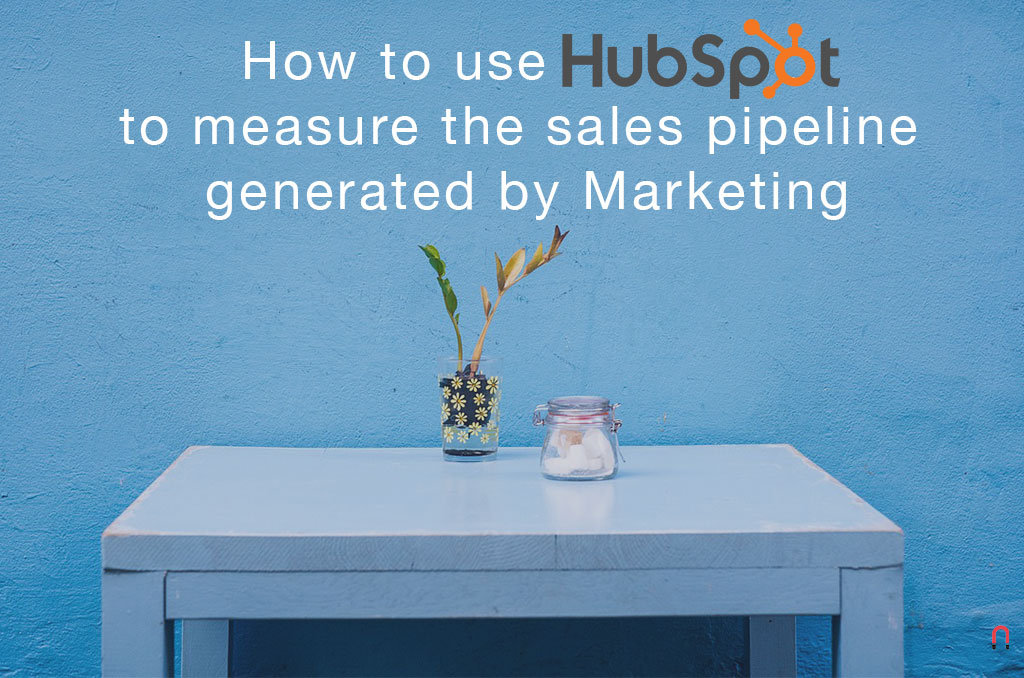How to use HubSpot to measure the sales pipeline generated by Marketing
 Sep 30, 2018 - Marcel Odena
Sep 30, 2018 - Marcel OdenaHubSpot is a tool designed for marketing , a global leader, both in the adoption of its use and all the features it offers. Not only it has very good features but also the implementation of these features in the tool is very successful, it is very easy to use. Its founders could be said to be the parents of Inbound Marketing, attraction marketing. If you are interested in learning more, I recommend reading the book “Inbound Marketing” by Brian Halligan and Dharmesh Shah, founders of Hubspot.
In our previous article we talked about how you can measure the marketing contribution when generating business for your company, to generate sales pipeline. I recommend that you read the article if you have not read it. We said that there are sales that are generated thanks to leads generated by marketing. And another part of the sales that are closed through leads that has achieved another department that is not marketing, but marketing has nevertheless managed to influence.
The big question at this point is: How can you measure the sales pipeline generated by marketing? The quick answer is very clear,with a powerful marketing tool that offers functionalities to do this. And this is where Hubspot comes into play.
Hubspot functionalities to measure the sales pipeline.
Hubspot has 3 functionalities that are essential to measure the contribution of marketing in the sales pipeline:
- Tracking the origin of leads.: It lets you know from which source the lead comes from.
- Lead activity tracking: It allows to know all the activity of the contact in our web, the behavior with the emails that we send to him, etc.
- Integration with Salesforce: it integrates very well with Salesforce, the B2B Sales CRM par excellence.
1. Origin of leads tracking function.
Hubspot has a very good lead measurement system, as standard, without having to implement anything. This system is very good because:
- It is precise.
- It is reliable.
Hubspot works with 3 variables to store the origin of the lead (contact).For each contact that enters Hubspot there is a value for these 3 fields, indicating the source origin of that lead. The fields are:
- Original source type
- Original source data 1
- Original source data 2
In the following image you can see these fields in Hubspot:
![]()
For example, imagine that we have a campaign on Linkedin to promote an ebook and generate leads through this campaign. If the URL of the ads landing is labeled with the correct UTMs (as I explained in this article), then for each lead (contact in Hubspot) there would be these values:
- Original source type = Paid Social
- Original source data 1 = LinkedIn
- Original source data 2 = “campaign id”
HubSpot has perfectly detailed the rules that follow to decide what values to put in these fields, you can check this updated information in this article from the official Hubspot website: How does HubSpot classify visits, contacts and customers in the Source Report?
Then I leave you an image of the table with these rules, to facilitate you if you want to see how those rules are. To see the latest version of this table, I recommend you access the official Hubspot article.

Rules table origin assignment of leads obtained from Hubspot article
On the other hand, a functionality that I find brutal is that Hubspot has a memory of the lead origin, despite not getting the lead at the moment when the user first visits our website. That is, imagine that a user clicks on our ad on Linkedin, reach the web (with well-labeled utms). Hubspot at that time leaves a cookie to the user, and links that cookie to their systems, assigning the information of the 3 variables on the origin of the visit. If that visit looks at several pages and leaves the web nothing happens, Hubspot has stayed with the information. Imagine that after a few days the user returns to visit our website and fill out the form to request a demo. At that moment the lead (contact) enters Hubspot, but the information of the origin of the contact is that of a few days ago, that is, the one that says that the user came through advertising on Linkedin.
Brutal, no? Actually, I do not know many marketing softwares that reach that level.
2. Lead activity tracking function
The other key functionality of HubSpot is that it measures all the contact activity with our digital assets and everything is registered. HubSpot measures and records a lot of information, among which the following stands out:
- What pages of the web the user visits, but not only of one day, at any time. If today the user enters the user and sees the home and the product page, it is registered. If after 5 days you re-enter and visit the home page and the price page, it is registered.
- All the activity with the emails we send you: is registered if the email has been delivered to you, if you have opened it, if you have clicked on the links that we put in the email.
- What forms are filled: we can have a form to download ebooks, another to request a demo, etc. All the submits are registered.
As you can see this information is invaluable for the marketing department to say that such contact, which became a sale, was influenced by marketing. Imagine that a contact that finally converts for sale does the following:
- Visit several pages of the web, over several weeks.
- Imagine that this user has downloaded some of the content that with such fondness has elaborated marketing, intended for their ideal buyer persona.
- Imagine that this user is opening the emails that we send him, as a result of a lead nurturing program that we have.
With all this information, recorded with a precision Swiss watch by HubSpot, how can anyone deny that that sale has not been influenced by marketing?
3. Integration function with Salesforce
HubSpot is an excellent tool as CRM for marketing automation. It has sales CRM functions also, you can generate opportunities, assign them statuses, account sales, etc. Still, it’s not the best sales CRM, this is where Salesforce comes into action. Therefore, many companies use the two softwares:
- Hubspot for marketing
- Salesforce for sales
Luckily for the professionals who are dedicated to this, the integration between HubSpot and Salesforce is pretty good . This means that:
- Contacts can be synchronized between Hubspot and Salesforce, as well as the value of the attributes of these contacts. This implies that if we get a lead through advertising on Linkedin the lead will enter HubSpot and after a while (as scheduled), it will be synchronized in Salesforce.
- There is the campaign concept in Salesforce, very useful because from Hubspot we can indicate that a lead has participated in a marketing campaign and pass this information to the campaign corresponding to Salesforce. And through this information we can quantify the volume of sales influenced by marketing.
All this why is it important? With what tool is the sales pipeline usually measured? with Salesforce, and therefore it is very important that all the relevant information about the origin of the leads and the activity of the lead is transferred to Salesforce, so that when the reports are released and the dashboards of the sales pipeline generated by marketing and the sales pipeline influenced by marketing are set up, the result is accurate and true.
Conclusion
HubSpot is an excellent tool for marketing automation, which includes two star functionalities to measure the contribution of marketing in the generation of sales pipeline. One function is to have a very accurate and reliable tracking on the origin of the leads. And the other is to have the ability to record all the activity of that contact with our digital assets.
I also tell you that, although excellent, the Hubspot that comes standard can be improved, to have an even finer tracking of both the origin of the leads and the subsequent interactions that the user has with our campaigns. But this is already the subject of another article.
I hope this article helps you and I encourage you to leave a comment!



